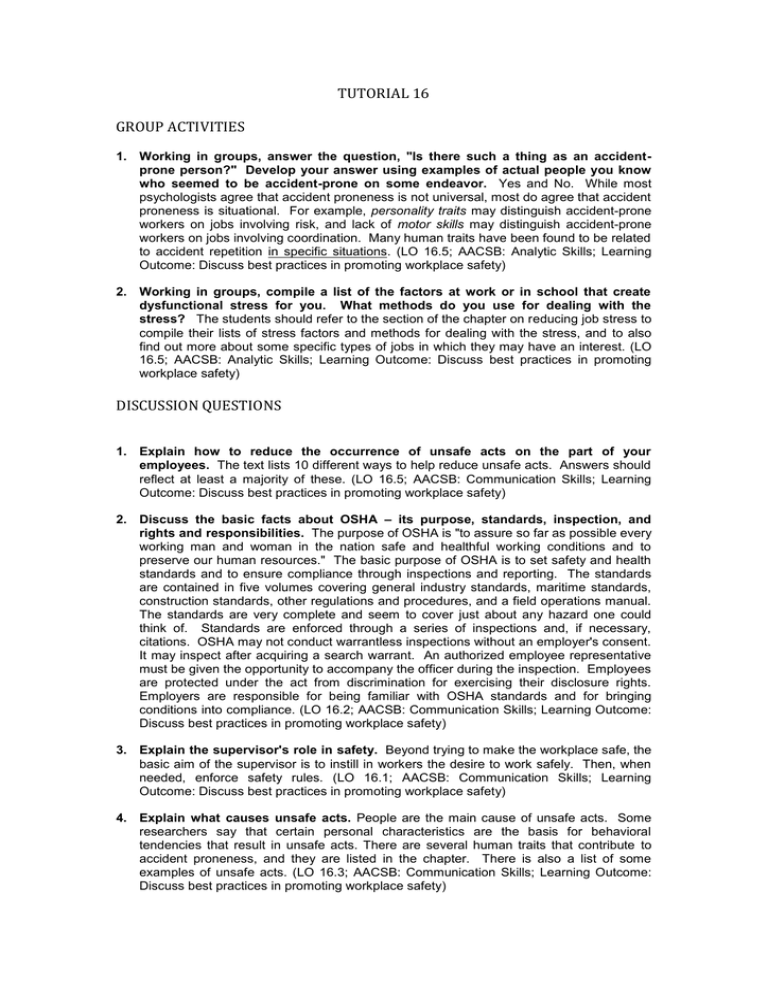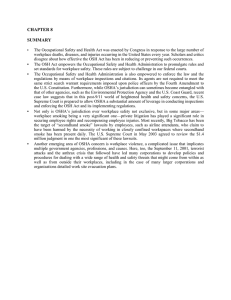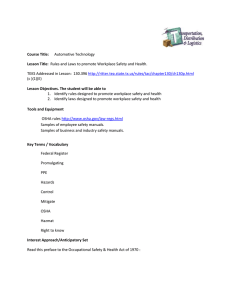T16-Solutions
advertisement

TUTORIAL 16 GROUP ACTIVITIES 1. Working in groups, answer the question, "Is there such a thing as an accidentprone person?" Develop your answer using examples of actual people you know who seemed to be accident-prone on some endeavor. Yes and No. While most psychologists agree that accident proneness is not universal, most do agree that accident proneness is situational. For example, personality traits may distinguish accident-prone workers on jobs involving risk, and lack of motor skills may distinguish accident-prone workers on jobs involving coordination. Many human traits have been found to be related to accident repetition in specific situations. (LO 16.5; AACSB: Analytic Skills; Learning Outcome: Discuss best practices in promoting workplace safety) 2. Working in groups, compile a list of the factors at work or in school that create dysfunctional stress for you. What methods do you use for dealing with the stress? The students should refer to the section of the chapter on reducing job stress to compile their lists of stress factors and methods for dealing with the stress, and to also find out more about some specific types of jobs in which they may have an interest. (LO 16.5; AACSB: Analytic Skills; Learning Outcome: Discuss best practices in promoting workplace safety) DISCUSSION QUESTIONS 1. Explain how to reduce the occurrence of unsafe acts on the part of your employees. The text lists 10 different ways to help reduce unsafe acts. Answers should reflect at least a majority of these. (LO 16.5; AACSB: Communication Skills; Learning Outcome: Discuss best practices in promoting workplace safety) 2. Discuss the basic facts about OSHA – its purpose, standards, inspection, and rights and responsibilities. The purpose of OSHA is "to assure so far as possible every working man and woman in the nation safe and healthful working conditions and to preserve our human resources." The basic purpose of OSHA is to set safety and health standards and to ensure compliance through inspections and reporting. The standards are contained in five volumes covering general industry standards, maritime standards, construction standards, other regulations and procedures, and a field operations manual. The standards are very complete and seem to cover just about any hazard one could think of. Standards are enforced through a series of inspections and, if necessary, citations. OSHA may not conduct warrantless inspections without an employer's consent. It may inspect after acquiring a search warrant. An authorized employee representative must be given the opportunity to accompany the officer during the inspection. Employees are protected under the act from discrimination for exercising their disclosure rights. Employers are responsible for being familiar with OSHA standards and for bringing conditions into compliance. (LO 16.2; AACSB: Communication Skills; Learning Outcome: Discuss best practices in promoting workplace safety) 3. Explain the supervisor's role in safety. Beyond trying to make the workplace safe, the basic aim of the supervisor is to instill in workers the desire to work safely. Then, when needed, enforce safety rules. (LO 16.1; AACSB: Communication Skills; Learning Outcome: Discuss best practices in promoting workplace safety) 4. Explain what causes unsafe acts. People are the main cause of unsafe acts. Some researchers say that certain personal characteristics are the basis for behavioral tendencies that result in unsafe acts. There are several human traits that contribute to accident proneness, and they are listed in the chapter. There is also a list of some examples of unsafe acts. (LO 16.3; AACSB: Communication Skills; Learning Outcome: Discuss best practices in promoting workplace safety) 5. Describe at least five techniques for reducing accidents. The text lists 10 techniques: 1) selection and placement; 2) posters and other propaganda; 3) training; 4) incentive programs and positive reinforcement; 5) top-management commitment; 6) emphasizing safety; 7) establishing a safety policy; 8) setting specific loss control goals; 9) conducting safety and health inspections; 10) monitoring work overload and stress. These are detailed in the chapter. (LO 16.4; AACSB: Communication Skills; Learning Outcome: Discuss best practices in promoting workplace safety) 6. Explain how you would reduce stress at work. Both environmental and personal factors can lead to job stress. If individuals are feeling dysfunctional levels of stress, the work schedule, pace of work, job security, and number or nature of clients, modifications in these factors should be made. Because personal factors influence stress, health and exercise programs can be promoted. Sometimes counseling should be offered, especially through an EAP, or a job more suitable to the individual should be found. Supervisors should monitor performance to identify symptoms of stress, and inform the employee of organizational remedies that may be available, such as job transfers or counseling. (LO 16.6; AACSB: Communication Skills; Learning Outcome: Discuss best practices in promoting workplace safety) 7. Describe the steps employers can take to reduce workplace violence. Some of the steps employers can take to reduce workplace violence include heightening security measures, improving employee screening, providing training on workplace violence, enhancing attention given to employee retention and dismissal of violent employees, instituting proactive measures for dealing with angry employees, and being aware of the legal constraints associated with workplace violence. (LO 16.5; AACSB: Communication Skills; Learning Outcome: Discuss best practices in promoting workplace safety)







